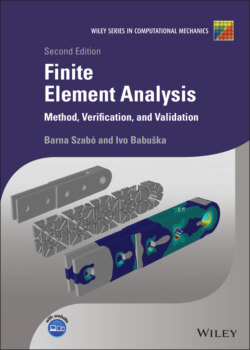Читать книгу Finite Element Analysis - Barna Szabó - Страница 33
1.3.7 Enforcement of Dirichlet boundary conditions
ОглавлениеWhen Dirichlet conditions are specified on either or both boundary points then is split into two functions; a function and an arbitrary specific function from , denoted by . We then seek such that
(1.79)
for all . Observe that the solution is independent of the choice of .
We denote the global numbers of the basis functions that are unity at and by K and L respectively. For instance, in Example 1.6 and . It is advantageous to define in terms of and :
(1.80)
as indicated in Fig. 1.6. When Dirichlet boundary condition is prescribed on only one of the boundary points then this expression is modified to include the term corresponding to that point only.
On substituting eq. (1.80) into eq. (1.79) the second term on the right‐hand side of eq. (1.79) can be written as
where Nu is the number of unconstrained equations, that is, the number of equations prior to enforcement of the Dirichlet boundary conditions. (For instance, in Example 1.6 .) The coefficients , are elements of the assembled coefficient matrix.
Figure 1.6 Recommended choice of the function in one dimension.
Since , we have and therefore the Kth and Lth rows of matrix are multiplied by zero and can be deleted. The Kth and Lth columns of matrix are multiplied by and respectively, summed and the resulting vector is transferred to the right‐hand side. The resulting coefficient matrix has the dimension N which is Nu minus the number of Dirichlet boundary conditions. The number N is called the number of degrees of freedom. It is the maximum number of linearly independent functions in .
Remark 1.7 In order to avoid having to renumber the coefficient matrix once the rows and columns corresponding to φK and φL were eliminated, all elements in the Kth and Lth rows and columns can be set to zero, with the exception of the diagonal elements, which are set to unity. The corresponding elements on the right hand side vector are set to û0 and ûℓ. This is illustrated by the following example.
Example 1.7 Consider the problem
the exact solution of which is
Using five elements of equal length on the interval and assigned to each element, find the finite element solution for this problem.
Referring to equations (1.66) and (1.70), the element‐level coefficient matrix for each element is
where we used , , . The assembled unconstrained coefficient matrix is:
Upon enforcement of the Dirichlet conditions the system of equations is
alternatively:
where the first and sixth equations are placeholders for the boundary conditions , . The solution is:
Exercise 1.14 Solve the problem in Example 1.7 with the boundary conditions , .
Exercise 1.15 Solve the problem in Example 1.7 with the boundary conditions , .
